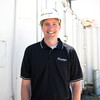Hi everyone,
We have a multifamily project with more than 100 units, and we have a doubt regarding the kitchen exhaust requirement for LEED. According to table 6-4 in ASHRAE 62.1 2010 the kitchens need an exhaust of 50 or 100 cfm regardless of if the range is electric or uses gas. However, section 5.6 allows to use recirculating hoods if there is non-combustion equipment, and the recirculating hood is designed to discharge indoors.
“5.6 Local Capture of Contaminants. The discharge from non-combustion equipment that captures the contaminants generated by the equipment shall be ducted directly to the outdoors.
Exception: Equipment specifically designed for discharge indoors in accordance with the manufacturer’s recommendations.”
Also, there is an ASHRAE interpretation (62.1 2010-9), where ASHRAE rules in item 1 that it is feasible to discharge indoors if allowed by the manufacturer when the space has an electric stove.
So, my question is: if the project has electric stoves, is it valid to use recirculating hoods in the kitchen to meet the LEED IQp1?
Thank you,
You rely on LEEDuser. Can we rely on you?
LEEDuser is supported by our premium members, not by advertisers.
- ASHRAE 62.1-2010 section 6.5 (which is part of the requirements from IEQp1), requires exhaust from the kitchen and doesn't limit this requirement by the type of stove; and ASHRAE explicitly states that it defines exhaust as air being directed to the outdoors in its Definitions section.
- In LEED v4 for Mid-rise IEQp1, which although is not NC, is pretty explicit that kitchen exhaust should be routed to the outdoors, without mention if the range is gas or electric.
- Since 2012 there is the LEED interpretation 10248, which granted was for LEED 2009, that states that kitchen exhaust (without qualifying if the range is gas or electric) is required to exhaust outdoors.
- Wouldn't that exception in section 5.6 be in direct contradiction to the exhaust requirements from section 6.5 in ASHRAE 62.1?
- ASHRAE has their own committee for resolving inquiries, but how does it interact or affect LEED projects?
So according to this, a recirculating hood is valid (if it complies with the ASHRAE 62.1 5.6 exception), but the air would still need to be exhausted from the kitchen to the outdoors "irrespective of the type of range provided" to comply with the requirement.
A recirculating hood cannot be used to meet the exhaust requirement for a residential kitchen. According to Table 6-4, residential kitchens must have 50 CFM continuous or 100 CFM intermittent exhaust, irrespective of the type of range provided. ASHRAE 62.1 Section 3 defines "air, exhaust" as "air removed from a space and discharged to outside the building by means of mechanical or natural ventilation systems." By definition, exhaust air must be sent directly to the outdoors, so recirculating range hoods do not comply. A recirculating range hood may discharge into the space if allowed by the manufacturer and permitted by local code, as noted in Interpretation 62.1 2010-9, but it does not qualify as exhaust. Note that the range hood is not required to be vented if the kitchen exhaust requirement is met independently of the range hood.
So replying to your questions:
1- as long as the fan exhaust 100 CFMs to the outdoors, at least from a LEED and ASHRAE perspective it wouldn't matter what type it is.
2- In general LEED calls for the most strigent code between ASHRAE and the local building code; so if the local building code doesn't require an exhaust for the kitchen (but ASHRAE 62.1 does), in order to achieve the LEED certification you would need to comply with the additional requirements from ASHRAE 62.1
Add new comment
To post a comment, you need to register for a LEEDuser Basic membership (free) or login to your existing profile.




